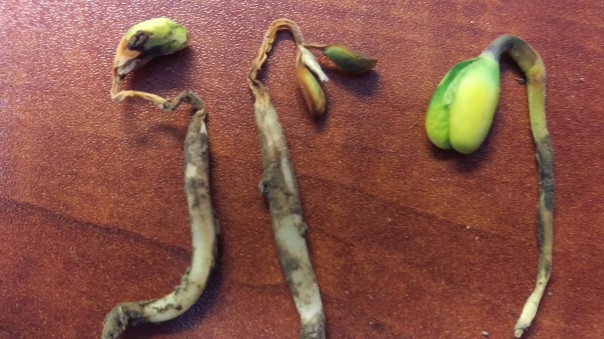Crop Update May 25

Yellow banding can be seen on corn plants from the cold temperatures at various times of the plant’s growth. Some have been packed with mud from rains or have wind-whipped leaves. I’m also seeing some evidence of seedling diseases caused most likely by Pythium sp. in portions of fields with excess moisture.


I’ve been asked to look at fields where soybeans appeared to be dying and/or had discoloration of the cotyledons and hypocotyls. Most of what I’m seeing thus far with the discoloration of cotyledons and hypocotyls have been in fields where a pre-emergent herbicide program containing a PPO inhibitor was used. These are helpful products in reducing weeds. We’ve just seen this in the past as well after rain events that the chemical can be rain-splashed onto the cotyledons and/or the plant is unable to outgrow the effects of the chemical quickly enough in comparison to the damage observed. Hopefully most of these fields will still be ok with plant stands if enough plants can grow out of it; we’d say to leave plant stands of at least 75,000 plants per acre because of the way soybeans compensate for reduced populations without a significant yield effect. There may also be situations of damping off diseases occurring in soybeans. They keys are to look at where the damage is occurring. Discoloration of the roots/below-ground stem would most likely be due to seedling diseases whereas, PPO injury will occur on the cotyledon and hypocotyl-so essentially above the soil. There could be instances where the stress of herbicide damage is also complimentary to Rhizoctonia root rot, but I haven’t sent any samples in to confirm this. The following article is from a few years ago, but summarizes the situations in which damage could more likely be anticipated: http://go.unl.edu/2jbf.

The symptoms on this soybean plant with the ‘halo’ effect on cotyledons is typical of what we see with ILeVO seed treatments. The effects will be on the cotyledon but not on the unifoliate leaves or above.

Soybeans planted April 21st at 2″ depth have been battered by recent rain and wind events. Currently close to V1 stage with first trifoliate unfurling.

Wheat is in various stages of pollination to beginning filling. Stripe rust and leaf rust continue to spread on leaves but wheat is past the point of fungicide application if it is over 50% pollinated.

Really pretty wheat field I’ve been watching this year. Very even growth and low incidence and severity of rust in this more resistant wheat variety.
Posted on June 5, 2017, in Crop Updates, Uncategorized and tagged corn, soybean, wheat. Bookmark the permalink. Leave a comment.

Leave a comment
Comments 0